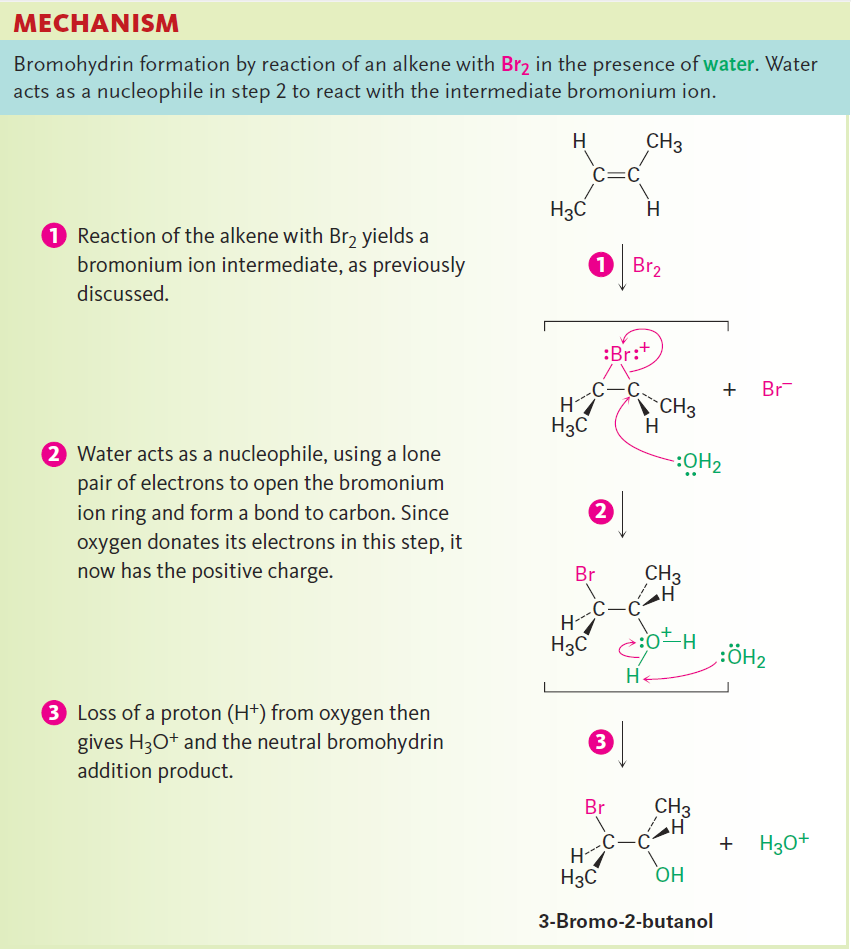
Halohydrins from Alkenes: Addition of HOX
 المؤلف:
John McMurry
المؤلف:
John McMurry
 المصدر:
Organic Chemistry
المصدر:
Organic Chemistry
 الجزء والصفحة:
9th-p 225
الجزء والصفحة:
9th-p 225
 21-7-2016
21-7-2016
 3774
3774
Halohydrins from Alkenes: Addition of HOX
Another example of an electrophilic addition is the reaction of alkenes with the hypohalous acids HO-Cl or HO-Br to yield 1,2-halo alcohols, called halohydrins. Halohydrin formation doesn’t take place by direct reaction of an alkene with HOBr or HOCl, however. Rather, the addition happens indirectly by reaction of the alkene with either Br2 or Cl2 in the presence of water.

We saw in the previous section that when Br2 reacts with an alkene, the cyclic bromonium ion intermediate reacts with the only nucleophile present, Br- ion. If the reaction is carried out in the presence of an additional nucleophile, however, the intermediate bromonium ion can be intercepted by the added nucleophile and diverted to a different product. In the presence of a high concentration of water, for instance, water competes with Br2 ion as a nucleophile and reacts with the bromonium ion intermediate to yield a bromohydrin. The net effect is addition of HO-Br to the alkene by the pathway shown Mechanism as below.

In practice, few alkenes are soluble in water, and bromohydrin formation is often carried out in a solvent such as aqueous dimethyl sulfoxide, CH3SOCH3 (DMSO), using a reagent called N-bromosuccinimide (NBS) as a source of Br2. NBS is a stable, easily handled compound that slowly decomposes in water to yield Br2 at a controlled rate. Bromine itself can also be used in the addition reaction, but it is more dangerous and more difficult to handle than NBS.

Note that the aromatic ring in the above example does not react with Br2 under such conditions, even though it appears to contain three carbon–carbon double bonds. Aromatic rings are a good deal more stable and less reactive than might be expected. There are a number of biological examples of halohydrin formation, particularly in marine organisms. As with halogenation halohydrin formation is carried out by haloperoxidases, which function by oxidizing Br- or Cl- ions to the corresponding HOBr or HOCl bonded to a metal atom in the enzyme. Electrophilic addition to the double bond of a substrate molecule then yields a bromonium or chloronium ion intermediate, and reaction with water gives the halohydrin. For example:

 الاكثر قراءة في الهايدروكاربونات
الاكثر قراءة في الهايدروكاربونات
 اخر الاخبار
اخر الاخبار
اخبار العتبة العباسية المقدسة


